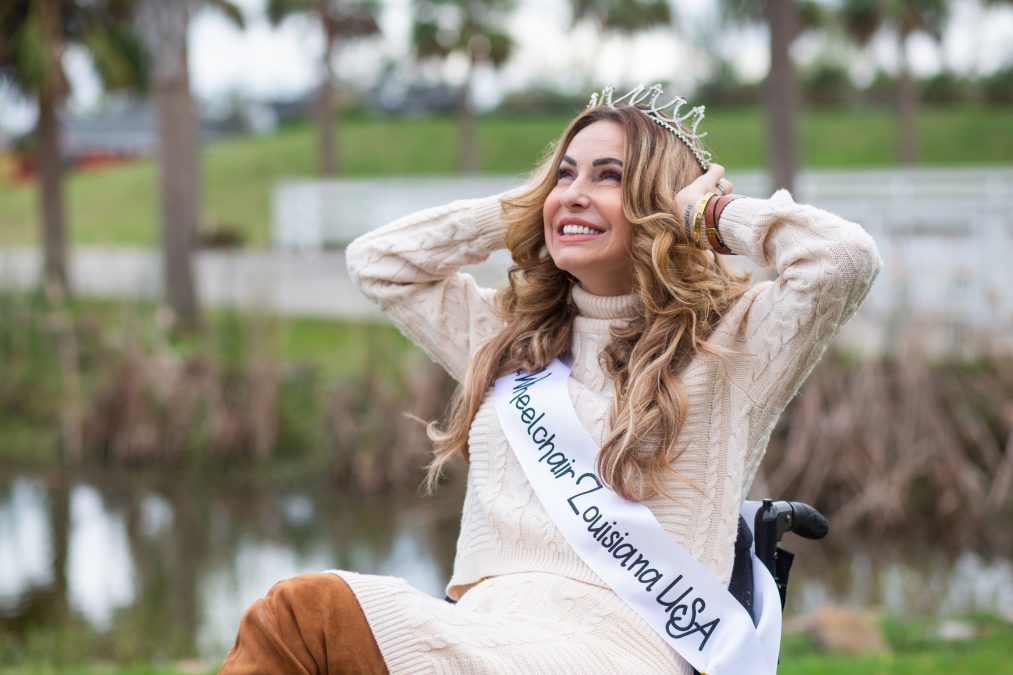
LDH reports over 100 new Covid deaths
January 25, 2022
United Way Souper Bowl Cook-Off is Back on Feb. 5
January 25, 2022February 21, 2020, was the day life changed for Macy Lauren Ledet. She and her two children left a Houma parade to go home to New Orleans when an RV collided with their vehicle on Highway 90. Not only were her children injured, but Macy was paralyzed on impact.
Macy actually didn’t make it at first–they had to bring her back. She spent five months in the hospital, three of those months spent in the ICU with a tracheotomy. She was released from the hospital in June of 2020 and it’s been a crazy journey since then.
“You go from being a very independent person who spent 38 years on the planet doing everything by yourself, and all of a sudden, that doesn’t work with your plan anymore,” Macy shared.
She couldn’t see her children the whole time she was in the hospital, sharing it was the most deafening experience of her life. She described it as dying twice, because “first you take my life, and then you take my children,” she reminisced. One of her biggest goals was to simply hug her children again.
While everyone sees Macy as an inspiration, she shared she didn’t deserve the title at first, simply because she was miserable. She didn’t know how to align her old identity with the new person she now was, “I didn’t know who that person in the mirror was,” she said.
Macy is a lawyer who practices in St. Charles Parish, and when the accident happened, she did what she has always done: drown herself in her work. While figuring out the ‘new’ Macy, she began researching quadriplegics all over the world to see what they were doing in their journeys.
“When I left the hospital I was told I would never be able to use my arms or my hands and I would never walk again,” she said. She just couldn’t accept what they were telling her what her life would be. This made her have a new purpose in life, “to find out why they keep telling us that this is all we’re ever going to be. I just couldn’t accept it, I really couldn’t,” she said.
She remembers laying in bed every night thinking that life couldn’t be what it is now, that there had to be something more. She started searching on social media and researching on the web for options. This led her to find a man who was one of the first people to do a study with the Department of Defense for a procedure called a nerve transfer.
A nerve transfer is when they take the nerves above the injury and connect a deadener nerve to an active nerve, similar to when you connect a ceiling fan to the wires in the ceiling using a co-ax.
“I decided to become a guinea pig,” Macy shared. “My whole purpose has been to find something out and then do it. Then document it.”
They cut Macy in four places on both arms and took nerves from the backside of her leg. She is currently a year and a month into the procedure and she has motion of her arms. She’s in a manual chair, and can use her fingers to type, write, feed herself, and do her makeup and hair. She can help her kids with their homework, and she is in the process of learning how to drive. She is doing things that people told her she would never be able to do, and she knows this isn’t the end of her journey.
The most critical time for a nerve transfer is within the first year of the injury which led her to feel she had to document her journey. She needed to let others know about the miraculous procedure and to get information out there that could help people that might not know there’s more to life than what they are being told.
She reached out to a family member that led Studio Six in San Francisco to pick up the documentary project. They are in the process of shooting Macy’s journey, but the documentary isn’t due to come out until Fall of 2022.
Macy doesn’t want anyone in that critical timeline to miss out on a chance at a better life. Her biggest goal is advocacy, so she started shooting her own videos to post on her social media to help figure out solutions to problems that disabled people face each and every day. She works on local, state, and federal levels to advocate for the simple things that are needed like access to buildings. She said she has to take crazy routes throughout downtown New Orleans just to get in buildings. She even wrote a protocol for learning how to drive and getting your license after experiencing going to Toro to get information on how to do so, and the staff wasn’t able to tell her. All while advocating, she’s still practicing law, bicycling, lifting weights, doing push-ups, and everything she can to get better and stronger.
Macy strives to set goals and then exceed them. She set up a manifestation board in her bedroom in January 2021 where she wrote her goals for the year on the large board. Some of the things she wrote were to be Ms. Wheelchair Louisiana USA, to become a successful editor, to shoot her gun since it was her passion before the accident, to solidify her law practice to bring in more associates, and to learn to walk again. As she looked at the list, there was one thing on the board she didn’t know how to achieve: to learn how to walk again.
“I don’t have the legs to walk – I do have the will to want to, but there’s got to be a way to make it work,” she said. This led Macy on another search to discover there is a facility in Thailand that conducted a procedure called epidural stimulation.
She found two clinics in the United States, one in Cleveland and the other in Louisville, where the Department of Defense has been conducting walking studies on injured military. The problem is the FDA won’t approve epidural stimulation until 2025. Macy learned that just like the nerve transfer, epidural stimulation also has a critical timeline. That pushed her to do everything in her power to get it done and to document the entire process.
During a timeline when COVID was prevalent, she said the process was difficult to get to a facility. She had to clear the visit with the embassy and even had someone contact the White House to try to get her there quickly. “It was a process,” she said, “but I knew I had a very limited time, as it had to be done within the first two years of injury, and I’m coming up on two years in February.”
She spent last summer at a satellite facility in Guadalajara. She spent 32 days in the facility where the procedure required putting a stimulator on her spine right below the injury. When the simulator was turned on, she could stand and take steps, move her legs and her feet, move her toes and balance herself. She described her experience in the facility as challenging because she always puts a high expectation on herself. She was previously a personal trainer and very active and thought it would be easy for her, but it took a little over 20 days to learn how to take steps. She eventually walked down a 50-foot hallway.
One of the most memorable moments in Guadalajara was when she stood up out of bed for the first time, swinging her legs around. “I was screaming crying, just freaking out,” she said. “I couldn’t believe it!”
Despite the recommendation against the procedure from her doctors due to the lack of research, Macy said they told her they want to hear everything about her procedure and journey because they can’t believe what they are seeing. “Now this is one of the top neurosurgeons in the country, if not, in the world, telling me he has no understanding of what I’m doing,” she said with wonder in her voice.
Looking back at her manifestation board, Macy proudly noted she received the Ms. Wheelchair Louisiana USA title for the second year in a row; has successfully put out six editorials this year; shot her gun, nailing four out of six shooting clays; went to Guadalajara and walked; and she can use her hands and her arms. She said one of the most important things about her journey is how it is affecting the people around her. Despite the journey being a challenge for her children to adjust to, she said they are doing better, they are doing unimaginable things for most kids their age and diving into things versus shying away.
“Sometimes I forget how strong I really am,” she said, “but when you’re in it, it’s so hard to see.”
She receives compliments from people saying she’s an inspiration, and she said she really appreciates it, but she has a specific vision of who she wants to receive the message. She wants family members of disabled people to see them in a very different light and she wants children to see people in wheelchairs not as a scary thing. Anytime she sees a child look and stare, she invites them to touch and get closer to show that it’s a normal thing. She is constantly advocating, sharing a positive message, and doing everything she can to make the world not seem so foreign to those who just need something done a little differently.
“It’s about taking your platform and taking however many followers you have and putting the information out there,” Macy shared. “It just so happens to be inspiring. For me, I had to fight SO hard to get the information, and you shouldn’t have to fight that hard. It should not be this hard.”












